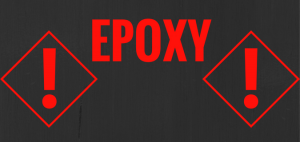 There is a great deal of misinformation and even fallacies about epoxy resins. Rumours of potential hazards of epoxy resin proliferate on the Internet. Lots of messages are written, without reliable sources, without sound scientific arguments, mere users presenting themselves as specialists…
There is a great deal of misinformation and even fallacies about epoxy resins. Rumours of potential hazards of epoxy resin proliferate on the Internet. Lots of messages are written, without reliable sources, without sound scientific arguments, mere users presenting themselves as specialists…
From time to time, we may also receive questions from customers worried about possible dangers of handling epoxy resins. Are there any risks in using epoxy resin? What safety precautions should be taken when working with thermosetting resins ? Let’s address these legitimate questions and demystify misconceptions about epoxy.
First of all people often incorrectly equate epoxy with polyester resin, which is composed of styrene (often more than 30-40% depending on the case). As opposed to epoxy, Polyester resin whose emanations are strongly odorous, is very toxic.
Of course, as with any product, there are different qualities of epoxy resin. It is not so unusual to find solvents in many resins sold on the market. But consumers have a right to demand manufacturers to develop formulas without volatile organic compounds (VOCs). This can only be done by thermosetting resins producers committed to develop environmentally safe products by selecting carefully raw materials.

Polymères Technologies is committed to protecting the environment and the health and safety of workers. Michel Roy and his team formulate epoxy and polyurethane systems without solvent and phthalates, which for the most part comply with the European RoHS * standard.
Yet, there is no denying that epoxy resin is a chemical product which, like any chemical, requires minimal safety precautions. Most of them are nothing more than common sense standards of conduct that any individual working with chemical product should follow.
For 25 years, our team has built an undeniable specific expertise in thermosetting resins. During all these years, we have never had serious incident or injury among our employee or customers.
However epoxy is known for being a skin sensitizer, frequently causing skin allergies such as dermatitis and eczema. Because sensitivity or tolerance may vary greatly from one person to another, the best precaution is therefore to avoid contact and splashing.
Here is a list of recommendations we suggest:
- Safe Storage: store product in a cool, dry, well-ventilated area. Keep out of the reach of children (This is by no means different from other common household cleaning products).
- Well-ventilated area: avoid working in a confined environment. If not, wear respiratory equipment.
- Wear approved safety equipment: full-body covering arms and legs, chemical splash goggles and waterproof gloves.
- Read material safety data sheets carefully before use and follow the protection guidelines.
* The European RoHS Directive (2002/95 / EC) aims to limit the use of six hazardous substances.
Learn More Sources:
Http://www.inrs.fr/media.html?refINRS=TA%2066
Http://www.rohsguide.com/rohs-categories.htm

